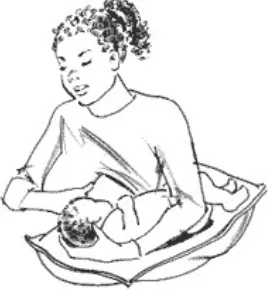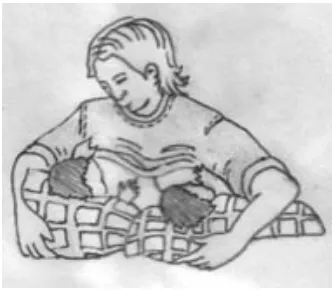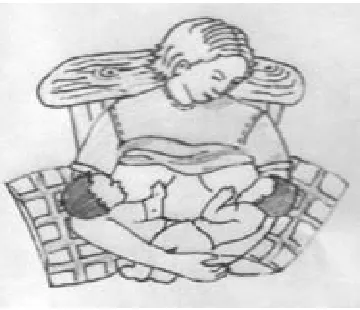THE BEST METHOD OF BABY’S FEEDING
IN EFFORT OF CARIES PREVENTION
Eriska Riyanti
Pediatric Dentistry Department Padjadjaran University Jl. Sekeloa Selatan Bandung
Abstract
Children high caries frequency in developing countries was a common problem. Nursing mouth caries was a condition that figured caries in children mouth associated with the habit of drinking milk using a bottle which contained fermentable carbohydrate or sweetened liquid such as milk and fruit juice along the day and as they sleep day or night. The lesions mostly localized on upper incisors labial, and/or upper molars palatal but rarely on the lower incisors. Avoid bottle usage while the child sleep, day or night, stop baby feeding too long in the night, do not let the child suckle all night and release them from the hilt immediately after finished, stop bottle usage after the child is 1 year old, they would be better to drink milk from a glass. The process of substituting mother’s milk to formulated milk has to be done slowly. Preparations to be a mother should be done thoroughly not only to achieve a healthy baby but also preparations to prevent caries, therefore they should always be informed about the proper way of baby feeding by the health centers and dentists.
Keywords: caries, bottle milk drinking, bottle milk.
INTRODUCTION
Dental caries had been an important problem in dentistry that needed attentions not
only from the medication sector but also from the prevention sector. High caries frequency was a common problem known, even though dental caries was rarely being life threating but it causes severe pain and hampers optimal health achievement.
Caries was a disease of tooth hard tissue that could affect email, dentin and cementum which caused by a microorganism activity in a fermentable carbohydrate. 1 According to
Wollinsky (1988), caries was a process of tooth destruction that was caused by the lost of hydroxyapatit crystals and demineralized matrix that result in the loss of tooth integrity formation. 2 This tooth destruction will create a cavity or a hole in the tooth. 3 Caries was also
a regressive, chronic process which started with the email minerals dissolved, as a result of impaired balance between the email and their environment because of microbial acid
Caries type that commonly found in preschool children was nursing mouth caries (NMC). Clinical features of the NMC have special pattern and type. 5,6 Its caries pattern was
obviously featured, with its main lesion in the upper incisors labial, and/or upper molars palatal. 7 Its caries type was parallel with the upper incisors gingival arch. The caries process tends to be active, another teeth would be affected as they erupted such as upper first molars,
lower canines and second molars but rarely affected the lower incisors, this could possibly happened because of their position were covered by the tongue. 6,8,9 Caries occurrence
processes in the maxilla and the mandible were depended on three factors which were eruption sequence, period of the habit, and muscle pattern while the baby suckles. 10
STAGES OF NURSING CARIES
Initial lesion of a caries in children happened immediately after eruption in form of
white pale colored demineralization lump along the upper anterior teeth gingival arch. It also could occur as a hole on the enamel surfaces in the same region. If this lesion developed it would be bright yellow, brown and then black colored. 11 White and brown patches and also
cavities in the buccal and lingual surfaces could be seen obviously with naked eyes or by using the mouth glass. 4 This initial lesion could also occur in the palatal surfaces and, in
severe condition, on the incisal tip of the tooth. The lesion that continued would extent along the gingival arch, formed in the neck of the tooth black colored, coincided by the extent loss of hard tissues. Teeth conditions in this phase would be in high risk of crown fracture. 11
This caries possessed special clinical manifestations, based on the stages that could be predicted by the teeth eruption pattern. The caries development stages were consisting of four
steps, which were: 12
proximal of upper anterior teeth. In this stage often parents did not realize that their child teeth were caught by caries. Dentists should be able to detect any tooth demineralization
that usually occurs several months after the tooth erupted.
2. Caries stage (tooth destruction stage). The lesion on the upper anterior extended to the dentin and showed tooth discoloration. Teeth usually affected were upper anterior on the
labial, lingual and sometimes on the proximal surfaces. Child maybe complained about pain while they were eating cold food such as ice cream. The first molar had already
caught initial caries.
3. Deep lesion stage. In this stage caries on the anterior teeth had already extended and deep. Depend on the time the tooth erupted, foods or drinks in bottle cariogenicity, and
frequency of drinks using a bottle, this stage could be achieved in 10 to 14 months. At this stage the upper first molar had already been in the caries stage, while the lower
molar was still on the initial stage. Usually there was a spontaneous pain in the upper incisors at night. Frequently the teeth became fragile thus this incisors easily fractured. This stage was an advanced bottle caries development. Then the teeth started to show
pulpitis symptoms. While the upper incisors maybe non vital. Lower first molar had already reached the second phase of bottle caries, and the upper and lower canine and
also the upper and lower second molar maybe reached the second phase.
4. Stopped caries stage. Every step would be stopped while the caries sources were removed. As the remineralization period partially or all of the caries lesions were
blackish-brown colored.
Giving milk through bottle was not the only cause for caries in children and maybe not a
According to Schuurs et al. (1992) causes for this caries were: drinking milk through the bottle in a long period of time (until more than one year old), drinking milk or any other
sweet drinks through the bottle near bedtime and every time the child expected it, baby and unconsciously even though the milk had already swallowed there were small amount of milk left in the oral cavity. If the mother also fell asleep and the baby did not released the hilt
from their mouth then the milk would flooded the baby’s mouth and contacted with the palatal surface of the upper incisors. 13 Milk would also flood the occlusal and lingual
surfaces of the posterior teeth. 11 There would also been stacks of milk on the cervical of the anterior teeth and lactose and also sugar fermentation contained in the milk accelerate the caries process. 14
Bacteria established in the oral cavity would turn sugar into acid, this acid which will cause enamel and dentin damage. 14 This lesion progress symmetrically affected the upper
and lower jaw and right and left side of the jaw. 11 While sleeping the amount of saliva production was decreased so that the cleansing effect of the oral cavity for the milk left on the teeth became slower. 6,13 Therefore if the saliva flow decreased or totally lost then the caries
may not be controlled. 1
DISCUSSION
in their first months, and the best of all available milk because it was uniquely accommodated for the baby needs. 15
According to a study by Gardner, Norwood, and Eisenson (1990) suggesting that from the four cases happened in children it was found a same pattern of caries and this condition associated with the baby feeding habit. This concluded that either mother’s milk or ox milk
could be cariogenic if the milk were left flooded the teeth. 6 NMC even found in the babies that received mother’s milk exclusively without ever received any milk from the bottle. 13
NMC was not only caused by giving food/milk using a bottle but could also cause by the inappropriate baby feeding. 7 Babies who fell asleep while suckled milk from their mothers can be assured to have a high risk of NMC. 13
Before baby feeding, mothers should wash their hands, and the hilt also should be cleansed with warm water. 16 Babies should be given milk as early as possible, things to be
concerned if they wanted to suckle milk that the baby is awake, in hungry condition, and suckled in a pleasing position. 17-20 There were several positions of baby feeding, which commonly done was the sit, standing and laying positions. While in the sit position, then the
mothers sit on a chair with a back rest so that their back would be supported. The best position was as follows, the baby faced down to the mother’s chest so while it suckles ears
Figure 1. Cradle position of baby feeding
Figure 2. Cross cradle position of baby feeding
Figure 4. Side-lying position of baby feeding
There were special positions regarding particular conditions such as for the twin
babies. Mother of a twin babies should be assured that she can baby feed her babies. First the mother could give to one baby each but actually she could give to both of the babies simultaneously. One of the positions quite easy to do was the football position.
Figure 5. Double rugby position of baby feeding for the twin babies
If she would baby feed simultaneously, the babies should suckle both of the hilts one
each time, do not suckle to one hilt only. The reason is, besides giving variations to the babies, babies suckle capabilities might be different, so the hilt stimulation should be balanced optimally.
Even though the football position was the best manner, the mother should be
15-30 minutes every time. If one of the baby had to be hospitalized, then baby feed to the baby at home from one hilt, then milk were extorted from the other hilt for the baby that was
hospitalized. 18-20
If the baby teeth were erupted, while the mother’s milk continued and given in laying position, the baby tends to experience teeth damage the same as those babies with a habit of
bottling. Recommendations of baby feeding were benefit most of the child development and health; it would be more complete if it was accompanied with the information of giving it. 7
Figure 6. Parallel position of baby feeding for the twin babies
From the description above it was clear that food which needed by the child in growth and development would instead be harming if it was given inappropriately. Government
programs in effective baby feeding could benefit in encouraging growth and development of the child mouth structure. But it needs to be balanced with the information about the appropriate manner so that unexpected diseases such as rampant caries could be prevented.
Government policies in emphasizing the promotive and preventive approach seemed to be appropriate in child dental care. 7
Avoid using bottle while sleeping, either day or night. While children drinking milk it would be better if the bottle was held by their parents. Do not let children held the bottle themselves because it would be difficult to wean. 21 Also stop baby feeding too long in the
night, do not let babies to drink milk all night and release the baby immediately from the hilt as finished. 13,21
Stop using milk after babies reach 1 year old, they should be better to drink milk from a glass. Most of children could hold a glass and learn to drink from a glass at that age. 21 Most of the baby slowly reduced their volume and frequency of mother’s milk starting at the age of
6 months until 12 months and would be accustomed with the solid food. Mother’s milk weaning had to be started by slowly reducing it and substitute with the formulated milk. This
should be done for several days and continued until the baby weaned completely. 15
Weaning process from giving milk from a bottle started with reducing the amount daily and started to give children drinks from glasses. At the age of 10 to 12 months reduce
CONCLUSION
Avoid using bottle while sleeping, either day or night, stop baby feeding for a long
period in the night, do not let children to drink milk along the night and immediately release them from the mothers hilt as they finished, stop using bottle after the children reach 1 year old, it would be better to drink from a glass. Mother’s milk weaning had to be started by
substituting it slowly with formulated milk. Mother preparations should be done thoroughly not only about to get a healthy baby but also about preventions of caries, therefore the mother
should always get an information regarding the appropriate manner of baby feeding through the health centers and dentists.
REFERENCES
1. Kidd, E. A. N. dan S. J. Bechal.. Dasar-dasar karies : penyakit dan
penanggulangannya. N. Sumawinata dan S. Faruk. Jakarta : Penerbit Buku Kedokteran EGC. 1992.
2. Wollinsky, L. E. Oral microbiology and immunology. Philadelphia: Saunders
Company. 1998.
3. Dhynsanjivani. Dental caries. http://www.dhyansanjivani.org. 2003. Accessed on April,
25th, 2008.
4. Schuurs, A. H. B., Moorer, W. R., Andersen, B. P. Patologi gigi-geligi: kelainan-kelainan jaringan keras gigi. Diterjemahkan oleh S. Suryo. Yogyakarta: Gadjah Mada
University Press. 1992.
5. Hattab, F. N., Al Omari, M. A. O. Manison, B. A. The prevalence of nursing caries in
one to four years old children in Jordan. J of Dent for Children. 1999: Jan-Feb:53-8. 6. Mc Donald, R. E., dan D. R. Avery.. Dentistry for the child and adolescent. 7th ed. St.
7. Soemartono, S. H. Pengaruh pola pemberian makan anak pada kesehatan gigi. Jakarta: FKG UI. 1998.
8. Koch, G. and Poulsen, S. Pedodontic a clinical approach. Copenhagen: Munksgaard. 2001.
9. Cameron, A. C. and Widmer, R. P. Handbook of pediatric dentistry. St. Louis: The C.
V. Mosby Company. 2003.
10. Ayhan, H. Influencing factor of nursing caries. The J of Clin Pediatric Dent. 1996:vol
20:4, 313-16.
11. Morris, R E., Gillespie, G., Dashti, A. Early childhood caries in Kuwait: review and policy recommendation. http://www.drgreene.com. Accessed on March, 14th 2008.
12. Andajani, L., Boenyamin, F. Karies botol pada anak dan penanggulangannya. Majalah Ilmiah Kedokteran Gigi FKG Usakti. Edisi Forum Ilmiah VI. 1999:114-9.
13. Cataldo, J. L. Breastfeeding nd a dental health. Available om fr URL:http://www.breastfeeding.org. Accessed September 14, 2008.
14. Jeong, H. Baby bottle caries. http://www.armymedicine.army.mil. Accessed on
November 30th 2007.
15. Behrman, R. E., Kliegman, R., Arvin, A. M. Nelson ilmu kesehatan anak. Edisi 15 Vol
1. Diterjemahkan dari Nelson textbook of pediatrics oleh A. S. Wahab. Jakarta: Penerbit Buku Kedokteran EGC. 1999.
16. Thompson, E. D. Introduction to maternity and pediatric nursing. Philadelphia: W. B.
Saunders Company. 1990.
17. Markum, A. H., Ismael, S., Alatas, H. Buku ajar ilmu kesehatan anak. Jilid 1. Jakarta:
FK – UI. 1991.
19. Pudjiadi, S. Ilmu Gizi Klinis pada Anak. Edisi Kedua. Jakarta: Balai Penerbit Fakultas Kedokteran Universitas Indonesia. 1993.
20. Wisnuwardhani, S. D. Praktek menyusui yang benar. http://www.geocities.com. Accessed on Juli, 1st 2008.
21. Mazzeo, N. Infant nursing an mportant i message for parents.
http://www.dcmilitary.com. Accessed on September 14th 2008.
22. Hait, E. Bottle mouth (bottle caries). http://www.nlm.nih.gov. Accessed on February 8th


